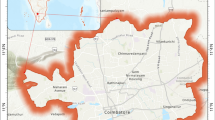Abstract
To compare the applicability of the leaves of horse chestnut (Aesculus hippocastanum) and linden (Tilia spp.) as biomonitors of trace element concentrations, a coupled approach of one- and two-dimensional Kohonen networks was applied for the first time. The self-organizing networks (SONs) and the self-organizing maps (SOMs) were applied on the database obtained for the element accumulation (Cr, Fe, Ni, Cu, Zn, Pb, V, As, Cd) and the SOM for the Pb isotopes in the leaves for a multiyear period (2002–2006). A. hippocastanum seems to be a more appropriate biomonitor since it showed more consistent results in the analysis of trace elements and Pb isotopes. The SOM proved to be a suitable and sensitive tool for assessing differences in trace element concentrations and for the Pb isotopic composition in leaves of different species. In addition, the SON provided more clear data on seasonal and temporal accumulation of trace elements in the leaves and could be recommended complementary to the SOM analysis of trace elements in biomonitoring studies.







Similar content being viewed by others
References
Aničić, M., Spasić, T., Tomašević, M., Rajšić, S., & Tasić, M. (2011). Trace elements accumulation and temporal trends in leaves of urban deciduous trees (Aesculus hippocastanum and Tilia spp.). Ecological Indicators, 11, 824–830.
Bargagli, R. (1998). Trace elements in terrestrial plants. An ecophysiological approach to biomonitoring and biorecovery. Heidelberg, Germany: Springer.
Deljanin, I., Antanasijević, D., Vuković, G., Aničić Urošević, M., Tomašević, M., Perić-Grujić, A., & Ristić, M. (2015). Lead spatio-temporal pattern identification in urban microenvironments using moss bags and the Kohonen self-organizing maps. Atmospheric Environment, 117, 180–186.
Flórez Revuelta, F., García Chamizo, J. M., García Rodríguez, J., & Hernández Sáez, A. (2004). Geodesic topographic product: an improvement to measure topology preservation of self-organizing neural networks, advances in artificial intelligence—IBERAMIA 2004. Lecture Notes in Computer Science, 3315, 841–850.
Hjortenkrans, D., Bergbäck, B., & Häggerud, A. (2006). New metal emission patterns in road traffic environments. Environmental Monitoring and Assessment, 117, 85–98.
Kalteh, A. M., Hjorth, P., & Berndtsson, R. (2008). Review of the self-organizing map (SOM) approach in water resources: analysis, modelling and application. Environmental Modelling and Software, 23, 835–845.
Kiang, M. Y. (2001). Extending the Kohonen self-organizing map networks for clustering analysis. Computational Statistics and Data Analysis, 38, 161–180.
Kohonen, T. (1982a). Analysis of a simple self-organizing process. Biological Cybernetics, 44, 135–140.
Kohonen, T. (1982b). Self-organized formation of topologically correct feature maps. Biological Cybernetics, 43, 59–69.
Kohonen, T. (2001). Self-organizing maps. In T. S. Huang, T. Kohonen, & M. R. Schroeder (Eds.), Springer series in information sciences (3rd ed., p. 501). Berlin Heidelberg: Springer.
Mari, M., Nadal, M., Schuhmacher, M., & Domingo, J. L. (2010). Applications of self-organizing maps for PCDD/F pattern recognition of environmental and biological samples to evaluate the impact of a hazardous waste incinerator. Environmental Science and Technology, 44, 3162–3168.
Markert, B. (1992). Establishing of “reference plant” for inorganic characterization of different plant species by chemical fingerprinting. Water, Air, and Soil Pollution, 64, 533–538.
Markert, B. (1993). Plants as biomonitors. In B. Markert (Ed.), Indicators for heavy metals in terrestrial environment (pp. 65–103). Weinheim, New York: VCH.
Mathworks, Inc (2011). Neural network toolbox, http://www.mathworks.com/products/neural-network/index.html. Accessed 26 Aug 2015.
Pérez-Aguila, R., Gómez-Gil, P., & Aguilera, A. (2005). Non-supervised classification of 2D color images using Kohonen networks and a novel metric. Progress in Pattern Recognition, Image Analysis and Applications Lecture Notes in Computer Science, 3773, 271–284.
Petrova, S., Yurukova, L., & Velcheva, I. (2014). Possibilities of using deciduous tree species in trace element biomonitoring in an urban area (Plovdiv, Bulgaria). Atmospheric Pollution Research, 5, 196–202.
Rajšić, S., Mijić, Z., Tasić, M., Radenković, M., & Joksić, J. (2008). Evaluation of the levels and sources of trace elements in urban particulate matter. Environmental Chemistry Letters, 6, 95–100.
Samecka-Cymerman, A., Stankiewicz, A., Kolon, K., & Kempers, A. J. (2009a). Bioindication of trace metals in Brachythecium rutabulum around a copper smelter in Legnica (southwest Poland): use of a new form of data presentation in the form of a self-organizing feature map. Archives of Environmental Contamination and Toxicology, 56, 717–722.
Samecka-Cymerman, A., Stankiewicz, A., Kolon, K., & Kempers, A. J. (2009b). Self-organizing feature map (neural networks) as a tool to select the best indicator of road traffic pollution (soil, leaves or bark of Robinia pseudoacacia L.). Environmental Pollution, 157, 2061–2065.
Serbula, S. M., Kalinović, T. S., Ilić, A. A., Kalinović, J. V., & Steharnik, M. M. (2013). Assessment of airborne heavy metal pollution using Pinus spp. and Tilia spp. Aerosol and Air Quality Research, 13, 563–573.
Šućur, K. M., Aničić, M. P., Tomašević, M. N., Antanasijević, D. Z., Perić-Grujić, A. A., & Ristić, M. Đ. (2010). Urbam deciduous tree leaves as biomonitors of trace element (As, V and Cd) atmospheric pollution in Belgrade, Serbia. Journal of the Serbian Chemical Society, 75, 1453–1461.
Tallis, M., Taylor, G., Sinnett, D., & Freer-Smith, P. (2011). Estimating the removal of atmospheric particulate pollution by the urban tree canopy of London, under current and future environments. Landscape and Urban Planning, 103, 129–138.
Tomašević, M., Antanasijević, D., Aničić, M., Deljanin, I., Perić-Grujić, A., & Ristić, M. (2013). Lead concentrations and isotope ratios in urban tree leaves. Ecological Indicators, 24, 504–509.
Veses, O., Mosteo, R., Ormad, M. P., & Ovelleiro, J. L. (2014). Freshwater sediment quality in Spain. Environmental Earth Sciences, 72, 2917–2929.
Acknowledgments
The authors acknowledge financial support from the Ministry of Education, Science and Technological Development of the Republic of Serbia, project nos. OI 172007 and III 43007.
Author information
Authors and Affiliations
Corresponding author
Rights and permissions
About this article
Cite this article
Deljanin, I., Antanasijević, D., Urošević, M.A. et al. The novel approach to the biomonitor survey using one- and two-dimensional Kohonen networks. Environ Monit Assess 187, 618 (2015). https://doi.org/10.1007/s10661-015-4842-6
Received:
Accepted:
Published:
DOI: https://doi.org/10.1007/s10661-015-4842-6




